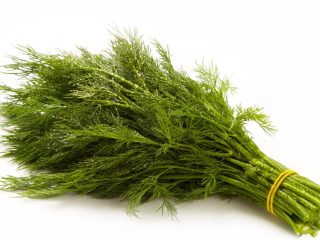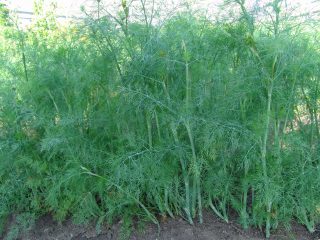Content
It is necessary to feed dill in open ground with nitrogen, potassium and phosphorus fertilizers. They can be purchased at any store, or you can make them yourself. Basic recipes and rules of use are described in the article.
Do I need to feed dill?
Like any other plant, dill needs feeding when grown in open ground. If you do not do this, then even in good soil the harvest will be smaller, and the plants will develop more slowly. Fertilizer needs to be applied for several reasons:
- The soil may be depleted and not fertile enough. In addition, the environment can be highly acidic or alkaline, which is why nutrients do not reach the plants in sufficient quantities.
- Fertilizing in spring is essential for rapid growth. This is especially important if the seed is poor and does not germinate.
- When dill turns yellow, this indicates a lack of nitrogen. Therefore, it is necessary to apply appropriate fertilizing, for example, urea or ammonium nitrate.
- Both a lack and an excess of nutrients are bad.So, reddening of the leaves indicates that there is too much potassium in the soil. In this case, stop feeding with potassium salt. This is necessary to restore balance.
Timing for applying fertilizers
When applying fertilizing, it is very important to choose the timing. Fertilizers are applied for the first time during the autumn digging of the soil for future planting. It is necessary to apply complex fertilizer (50 g per 1 m2) or add compost, humus in the amount of 1 bucket per square meter. If the soil is clayey, you should also add sand or sawdust up to 5 kg to the same area.
Further fertilizing is applied according to the following schedule:
- Two weeks after mass germination, nitrogen compounds are given.
- After two weeks, you can add nitrogen again if the dill grows poorly and produces yellow foliage.
- Further, fertilizing in the open ground is done as needed - if the soil is fertile and the plants develop normally, they do not need to be fed.

Fertilizers are applied for the first time two weeks after germination.
How to fertilize dill in open ground
For dill, you can use almost any fertilizer - organic, mineral, complex. Folk remedies are also suitable. They are no less effective and cost practically nothing. The main composition options are described below.
Organic fertilizers
To make dill grow better, it can be fertilized with organic matter. They contain a rich set of elements, including nitrogen, phosphorus and potassium.They ensure rapid growth, a set of green mass, and increase the plant’s immunity. Among the main organic fertilizers are the following:
- Humus and compost - these substances are added in the amount of one bucket per square meter when digging.
- A water infusion of mullein 1:10 is used in the spring. It can be watered over dill for rapid growth.
- Bird droppings are used for a similar purpose, applied at the same time. This is a very concentrated fertilizer, so it must be diluted with water at least in a ratio of 1:20.
- Urea (urea) is an excellent source of nitrogen. It is gradually absorbed by plants and saturates the soil with valuable substances. Provides a quick set of green mass of dill.
Green manures are also often used from organic matter. This is the name given to plants that provide the soil with nitrogen and improve its composition and structure. The most common green manures include mustard, alfalfa, peas, clover, lupine, vetch and others. Sowing is planned for both spring and autumn. The plants are allowed to develop to the flowering stage and then chopped, mowed and incorporated into the soil.
Mineral supplements
You can also feed dill in the greenhouse, on the balcony and in the open ground with mineral compounds. The most effective means for rapid growth include:
- Nitrate – ammonium, calcium, sodium.
- Superphosphates (single, double).
- Potassium compounds (in the form of sulfate, potassium nitrate, potassium salt).
- Dill is fertilized with ammonia. This is an aqueous solution of ammonia, which can be purchased at any pharmacy. It is a source of nitrogen and also a preventative against pests. You can add alcohol two weeks after germination - 10 ml per 10 liters. After another two weeks, the same composition is added.
All the described mineral preparations are necessary not only for the rapid growth of dill, but also for the formation of inflorescences. Immediately after emergence, emphasis is placed on superphosphate and potassium compounds. If you don’t have time to prepare the mixture yourself, you can add complex fertilizers described below.

Ammonium nitrate is one of the best sources of easily digestible nitrogen
Complex fertilizers
Among the complex fertilizers for dill, several effective preparations can be distinguished:
- "Bio Absolute";
- "Forte"
- "Grow";
- "Razion";
- "Vermicompost";
- NovaTec Solub.
Each of these products contains vital components - nitrogen, phosphorus and potassium, as well as trace elements. They promote rapid growth of green mass and strengthen the immune system. All drugs are used strictly according to the instructions. Even if dill clearly lacks microelements, you should not add too many substances, since excess is even more harmful than deficiency.
Humic fertilizers
Liquid humic fertilizer is sold in any store for summer residents. It is prepared on the basis of peat, compost, and muddy sediments. You can purchase the drug "Biud", which contains several types of manure. The concentrate is diluted in water 20 times.
How to feed dill with folk remedies
You can also use folk remedies to feed dill. For example, an infusion of nettle is suitable. To prepare it, proceed as follows:
- Young plants that do not yet have seeds are harvested.
- Grind a little and fill buckets or barrels tightly to 2/3 of the volume.
- Fill with water, add yeast or bread, kvass - products that stimulate fermentation.
- Infuse the dill fertilizer at room temperature for a week, stirring occasionally.
- When the infusion darkens and stops producing bubbles, the dill supplement is ready.
- It is diluted 10 times. Water the dill at the root.
Another top dressing based on folk recipes is yeast infusion. Take 100 g of dry raw material, dilute it in the same amount of warm water (half a glass) and leave for 2-3 hours. Then dilute it in a bucket (10 l) and water it.
Onion peel is a good fertilizer and a natural bactericidal agent for the prevention of infectious diseases of dill. To prepare the fertilizer, take husks in an amount of 500-700 g, boil for several minutes in a small volume of water, then filter and dilute to 10 liters.

Onion peels are used as a fertilizer and bactericide.
Wood ash is often recommended for feeding dill. This is a good fertilizer, but it alkalizes the soil, i.e. increases pH. Therefore, it should only be used on acidic soils with a pH less than 5.0. If the soil is slightly acidic, neutral or alkaline, wood ash cannot be used.
Rules for applying fertilizers
When applying fertilizing for dill, several rules are taken into account:
- Organic matter (compost, humus, peat) should be covered before planting the crop. It releases nutrients slowly, so it will take 6-8 months for complete decomposition. Accordingly, such compositions should be incorporated into the soil in the fall before planting.
- Mineral fertilizers should be alternated with liquid organic fertilizers (humic, mullein, bird droppings in the form of a water infusion).
- All mineral and complex compositions are applied exactly according to the instructions. If necessary, quantities are measured independently. It is better to do this not “by eye”, but with the help of scales and measuring utensils.
- After watering with a solution of fertilizers, the soil should be loosened and the beds should be weeded if necessary. This saturates the soil with oxygen, the roots get enough air, and the plants develop even faster.
Conclusion
Dill should be fed in open ground on the eve of planting (six months before preparing the site), as well as two weeks after the appearance of mass shoots. The rest of the time, fertilizers are applied as needed, monitoring the external condition of the plants. If they develop normally and do not turn yellow, you should not add extra substances to the soil.








